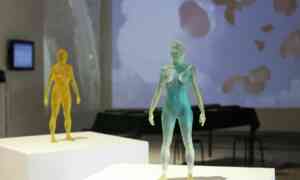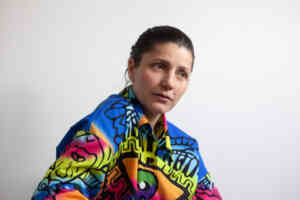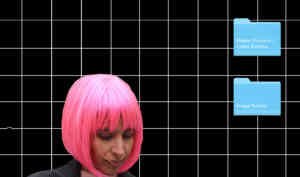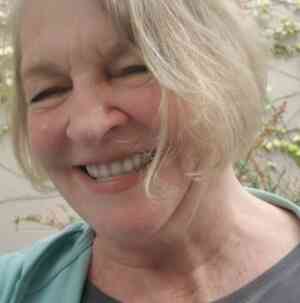Writing women’s histories

We live in times that demand reflection, patience, and optimism. If you are anything like me, you are exhausted from hearing ‘we are all in this together,’ as it can ignore all the aspects of life when we are not. Despite the current circumstances, it is a good time to recognize the important contributions and stories of women media artists, who continue to explore and actively participate in contemporary art and discourse, despite the many restrictions. We can also take a moment to appreciate how our creative lives and personal histories are interconnected, as we connect online almost exclusively. All our stories are unique, but we are generally joined by the common passion for our work and the belief that media and art provide new ways to understand and talk about some extraordinarily complex issues.
When I first encountered Feminism in the 1970s, I was an eager and optimistic MFA student exploring video art. As a member of the ‘Museum and Gallery Studies’ graduate program, I was lucky to land an internship at the local Long Beach Museum of Art, at an institution that supported video artists’ production and exhibition. Feminism at that time - especially in California- was intertwined with women’s liberation, sexual freedom, and equal rights. Powerful motives! I was influenced by the female artists I encountered while working at the Museum. I met Martha Rosler, Nancy Buchanan, Barbara Smith, Suzanne Lacy, and others who were active in the emerging video and performance art scene. They were self-identified feminists, and in my role as a helper, I discovered how they worked and embraced the new ‘technical’ video medium for its intimacy and directness (important ingredients of feminist communication). These artists were also connected to an important alternative center, The Women’s Building in downtown Los Angeles, an active and dynamic mecca for women artists between 1973-1991. The Museum was also a partner in the Building’s video productions and public programs. This history has been written for the LB Museum of Art’s exhibition catalog “Exchange and Evolution” (2011), part of The Getty’s Pacific Standard Time series.
Now, looking back, I see why I associate feminism with media art. But I’m also aware of the numerous stories and histories surrounding the excitement of early video art, individual artists and the feminist art community that have not been told. Who should write these histories? Hence, this article. I clearly recall that during my early years as a curator, how I actively searched for critical information about Feminist media artists, and later female digital artists. But there was rarely enough, if any, information to satisfy my curiosity. I now realize that this era was history in the making: in basements, alternative galleries, at festival bars, in artists’ lofts, and in the classrooms of progressive art schools. So, instead I found my essential information about upcoming talent, new work and exhibitions from artists and first-hand experience. Of course, information exchanges depended on establishing associations and sharing confidences with artists and was the typical style of operating for an entire generation of (now) ‘senior’ curators, artists, and art writers.
I moved to Europe in the early 1990s, and during frequent travels around central and eastern Europe,
found encouragement from and collaboration with the female artists I met in the emerging digital art
community. Feeling outnumbered and disregarded by our male colleagues, and to strengthen our cross
border connections, the online community of women, FACES: Gender, Technology was founded in 1997. Today it is an international network and an online space for women and
female identified artists, activists, and programmers, and currently has 500+ members. FACES provides a
platform where women can connect, meet, exchange ideas, share information about their work, and
lend support virtually as well as in person (whenever that’s possible) without needing to assume labels
of any kind. FACES also self-organize informal gatherings at international events and festivals on several
continents. Most importantly, FACES is a place where no men talk over women or shut them down.
Lynn Hershman Leeson, Marina Gržinić, and Charlotte Eifler, each offer great examples of our shared
history. Each have revealed formerly unknown, alternative histories, using experimental film and video
techniques to reveal stories that are important keys to our collective feminist history. Each work
embraces feminism as a positive and driving force for empowerment. Each work contextualizes the
movement as it relates to several generations, across cultures, while embracing the political realities of
the time: from California’s anti-war era of the 60s, to the gay rights struggle in the former Yugoslavian
state of Slovenia, to the digging into the importance of the 90s and the formation of an international
online community of women, they are unique stories that are ambitious yet personal reflections of each
artist. These works focus on the artists’ influences, and by their hand they bring forward otherwise
unique, untold feminist stories.

Lynn Hershman Leeson (1941), one of America’s most prominent
feminist artists, has created works since the 1960s across a wide range of styles using alternative and
experimental media as well as traditional materials. She is a known Bay Area artist who I’ve been in
contact with since the early 1980s and have been influenced by her ongoing dedication to explore
female issues. She is now, finally, legendary, after many years of working outside the popular,
mainstream art concerns. So much has been written about her, and her huge body of work establishes
her as a feminist artist and role model for many. At the premier Berlinale screening, I was as impressed as many were when Lynn presented her feature
film “!Women Art Revolution” or “!W.A.R.” (2010 83 min). The
film is a compilation of 40 years of Lynn’s personal recordings of interactions with feminist performance
artists. She calls the work ‘a secret history’ because it captures the history of the feminist art movement
in the United States, beginning in 1960, when it was in direct contact with the anti-war, free speech
movement of the time. Using a borrowed camera, she began recording interviews and performances by
artists who were unrecognized by the art community. After four decades, she realized that many of the
female artists she had documented still had not been recognized, so she began to work with the footage
she had accumulated. She discovered a cache of information missing from textbooks and journals. Lynn
created the story of feminist performance art from what she had witnessed personally, at a time when
the art scene was otherwise completely dominated by men.
!W.A.R. has received widespread acknowledgement at film festivals, by museums, and as a topic for art critical review. The complete archive of video is available online and can be accessed by anyone, making available all the video footage that she could not incorporate into the actual film. The film is distributed theatrically and on DVD worldwide by the New York based Zeitgeist Films. It is also streamed for free (with ads) on Amazon Prime.

Marina Gržinić (1958) has created “Relations: LESBIAN MOVEMENT/25 years of the Lesbian Group ŠKUC-LL Ljubljana” (2012 1:24:27) to celebrate the 25th anniversary (1987-2012) of the groups’ motivations, concerns, and influence in former Yugoslavia. The work is self-produced and unfunded, and according to Marina has had little recognition nationally. The feature length film recounts the early days of 1980s gay rights activism in the former Soviet influenced region, as told by the historians who participated in the Lesbian movement. Their recollections are told in conversation with Marina (in the Slovenian language with English subtitles). The video/film includes analysis of the gay rights movement in Ljubljana from the beginning in 1987 through Slovenia’s entry into the EU after 2004. ‘Relations’ includes discussions and analysis of the ‘cultural climate’ that surrounded the discussions and rejection of a new family code in Slovenia, which was rejected by a referendum in March 2012. A victory for human rights, most of Slovenia’s voters decided on basic human rights for same-sex unions and their children. A special place is given in the film to the Pride Parades in the ex-Yugoslavian territory and give the interviews agency along with documentation of cultural events, and news footage of political events that mark epochs.
‘Relations’ reveals more than the story of a sub-culture of the LBGTQ community, it also clearly presents the Lesbian code of care for others, all ‘others’: refugees, immigrants, and those people who fall outside the established concerns of the state and social consciousness. The memories of the participants reveal wider impressions, especially how the feminist, lesbian movement in Ljubljana concerned itself with community issues. Slovenia, one of the earliest countries to extract itself from Yugoslavia and its former Soviet-based political links became a leader for human rights in east European progressive movements. The SKUC-LL group was part of that successful energy. Marina, an internationally recognized video artist, was a director at the SKUC Gallery in the early 1980s where she supported early controversial and politically charged programs. Her role in the history at the SKUC Gallery and the artists who received her support is not known widely. SKUC was founded in 1978 as a non-governmental cultural center, but it was more than a venue and functioned as a lifeline to many. It was ‘a must’ to be associated with this program and constellation of artists, curators, and art historians at the time.

Charlotte Eifler (1986) is a German millenial, a multi-media artist who is among the first in a generation
of artists to grow up between the east and west in a digital world that knows no boundaries, no borders. She embraces the future with her video work “Feminism is a Browser“ (2019 15 min), a short work inspired by a generation of feminists who were online and active in the 1990s, women who she recognizes led the way to establish female identity online. Her work questions who have the power to represent, to show, to distribute and evaluate images and information. Charlotte embraces the internet and all it has to offer. But, she would like to know more about the utopia of the 90s, its passion, and the dreams and hopes of that first generation of a virtually connected women. In this process, she works intersectionally to create a feminist revision of the Internet by listening to the stories from an earlier generation. It is how she makes this history visible and believable. She wants to be prepared for the virtual future, as it interfaces with the real physical world.

“Feminism is a Browser” embraces the cross generational nature of the connections on the FACES online community. A hybrid docu-narrative with sci-fi elements it utilizes digital technology at its best. Charlotte removes herself from the dialogue, and uses her creation Yeva, a cyber-entity who narrates this wide- ranging search across cultures and generations. Yeva, when they are ‘reborn’ into the real world, become human and curious. Their quest is to connect the digital world of their origin with the real world of pioneering female artists who created FACES. Yeva begins the exploration by researching the online archives that span more than twenty years, and by meeting up with members of the network, asks them for guidance; Perry Bard, Jenny Marketou, and Diana McCarty are among these ‘mothers.’ Charlotte writes, ‘Having grown up on the Internet in the ’90s, possessing knowledge gleaned from the entire email archive of the FACES network, Yeva wants to amplify and relate to the “herstories” of those media pioneers, while keeping a lookout for allies of their own generation.”
“Feminism is a Browser” received production and research support from the German media center Werkleitz Gesellschaft, through their 2018/19 Professional Media Master Class Lab for documentary practice on the web. She had further opportunities to travel to the United States with a stipendium in New York in 2019, as part of the International Studio and Curatorial Program, when she also visited Southern California. Charlotte hopes to make the complete archive of interviews available online in the near future.
We each have a responsibility to tell our stories, to entrust our memories with others and therefore build a strong history and system of pride and support. We should flood the infosphere with the stories of amazing feminist interventions that should grow to dominate art theory, practice, and philosophy. Lynn Hershman Leeson, Marina Gržinić, and Charlotte Eifler have done exactly this, for different reasons and with different outcomes. They have made significant contributions to our understanding of Feminist artists, and the deep knowledge that most women’s stories are not being taken seriously when indeed they offer amazing insights to survival and achievement

